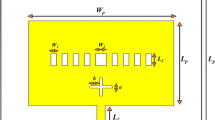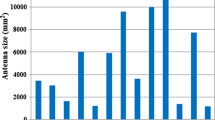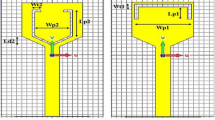Abstract
This article introduces the new design of a compact slotted microstrip patch antenna. Here, rectangular slotted antenna is constructed by single feed with multi bands of frequencies. Two dissimilar rectangular blocks are attached to both sides of radiating edges and hence decreases the dimension of the proposed structure by correspondingly minimizing the resonance operating frequency. Different frequencies are found by using two rectangular slots with different dimensions are used in the both radiating edges of proposed antenna. In this proposed design, it is found that the patch antenna dimension has been minimized up to 68% with an enhanced the ratio between high to low resonance frequency. The parameter behaviors of the designed multiband slotted antenna are studied with the help of the most common MoM-based simulator IE3D.
Access provided by Autonomous University of Puebla. Download conference paper PDF
Similar content being viewed by others
Keywords
1 Introduction
In many wireless broad band communication systems, application of the multiband frequencies are very commonly used. Hence, the multiband antennas have more requirement in telecommunication system. The most common and suitable antenna for wireless communication and broad band system is microstrip patch antenna and very flexible sophisticated devices due to its low profile structure, it is a most suitable structure for wireless broad band communication. The microstrip antenna is the major choice to operate in wireless communication because the size of communication device depends on this antenna. Therefore, one of the best methods to minimize the dimension of the communication system is by reducing the antenna. The most common way of them is by proper adjustment of ground plane and patch dimension [1,2,3,4,5,6,7,8,9,10]. The suitable method of patch adjustment is cutting the slots in proper sizes. [1, 2] obtained the minimized size antenna by 50% and obtained 400 MHz resonance frequency range. [3] reported that designed structure has been minimized by 84%. Multi-range frequencies are used in parallel polarization planes and by reduction of antenna size. The performance of the antenna depends on the thickness of the textile substrate material [4]. In [5, 6], the miniaturized antenna was fabricated with resonant frequency of 3.5 GHz for WiMAX application. [7] reported rectangular slits at two sides of the patch. Compared with the conventional rectangular patch antenna, this antenna can improve reduction in patch size up to 71%. The proposed antenna designed by us also represents the compact multiband frequency of antenna is obtained by cutting the double rectangular slots with different dimensions on radiating surface edges of the microstrip patch material. We designed a compact microstrip patch antenna, and it operates in multiband frequency range by properly adjusting the radiating slots and ground plan. Due to the presence of slots in the radiating patch, the multiple band of resonance frequencies found and dimension of the microstrip patch antenna has been minimized. The proposed designed compact antenna is better than rectangular plane or ground plane structure [1, 2].The unequal rectangular-shaped compact multi-frequency microstrip patch antenna proposed by us should be applied in many telecommunication systems because of its compact profile structure and overall excellent working features.
2 Basic Structure Geometry
Basic parameters of conventional patch antenna are calculated by the conventional mathematical equations [8,9,10]. The dimension of the antenna is find by using generalized equations and found as L = 16 mm and W = 12 mm at the center operating resonance frequency at 5.6 GHz. Here, the conductive height is 1.567 mm, and selected dielectric material FR4 is 4.4. The conventional unslotted patch antenna geometry structure shown in Fig. 1 having L1 = 13 mm and W1 = 17 mm using Coaxial probe feed with probe radius is 0.5 mm has been positioned at a location (X = 2 mm, Y = 0 mm) w.r.t the origin of the unslotted conventional antenna. The structure of proposed slotted rectangular microstrip antenna is shown is Fig. 2. Here, one pair of unequal rectangular slots are placed at the both opposite sides of the patch antenna. Thus, minimized the size of the antenna and increases the band of frequencies from the designed antenna. Similarly, coaxial probe feeding used at the location X = 1.6 mm in conventional unslotted rectangular antenna. The optimized data of the proposed antenna dimension are: W1 = 17 mm, L1 = 13 mm, W2 = 2.5 mm, W3 = 2.5 mm L3 = 6.5 mm, L2 = 5.5 mm, W4 = 1.5 mm, W5 = 1.5 mm, and X = 1.6 mm. The fabricated designed conventional antenna and proposed slotted antenna are shown in Figs. 3 and Fig. 4, respectively.
3 Parameter Analysis of Proposed Compact Antenna
The variation of antenna parameters with the variation of different values of dimensions of the slotted microstrip antenna have been measured by MoM-based simulator [11, 12]. For a single rectangular-slotted antenna given in Fig. 5 exhibits two different band of resonance frequencies are 6.2 GHz and 7.51 GHz with optimum value of slot dimension as W2 = 3.5 mm and L1 = 5 mm having below −10 dB level of reflection coefficient. For proposed bi-rectangular slotted microstrip antenna with dimension W3 = 3 mm and L3 = 6 mm shown in Fig. 6. Because of the dual slot, the resonant frequencies are shifted and obtained at 5.42, 6.72, and 8.36 GHz below of −10 dB (ref. coefficient). The variation characteristics of ref. coefficients for different slot dimensions for a fixed interval of deviation is shown in Fig. 7 referred to the Table 1. From the simulated results, it is found that for any variations of dimension of slotted antenna, the resonance frequency may be varied. Thus, the antenna will not fulfill the properties of compactness.
4 Conventional Versus Design Proposed Antenna
Here, we discussed the variation of current distribution of conventional and proposed slotted antenna. With the use of surface current distribution, the working principle of proposed and conventional antenna is analyzed. For different resonant frequencies, current distribution of the unslotted conventional antenna and proposed antenna is shown in Fig. 8a–e. Here, current density has been increased with increases the cutting slots Fig. 8b–e. Figure 8a–e shows that the current density characteristics are different for both conventional and proposed antenna because of their double cutting slots. Fig. 8b–e shows the maximum surface current density than conventional antenna in Fig. 8a. The number of resonance frequencies can be increased by introducing the open-ended slot at the patch surface edges without any disturbance of the surface current and smoothly distributed the electric and magnetic fields.
5 Antenna Results and Discussion
At first, the simulated results of reflection coefficients of slotted compact antenna and conventional antenna were measured and studied using IE3D simulation software. Most common analyzer Agilent E5071B is used to measure the value of reflection coefficient of proposed compact antenna. The simulated and measured results of conventional antenna and proposed slotted antenna are shown in Figs. 9 and 10, respectively. In both cases, the obtained frequency is 5.55 GHz with reflection coefficient of about −36 and −24 dB, respectively. Due to the introduction of the cutting slots in proposed antenna, the multi-resonance frequencies found at 3.42 GHz, 5.42 GHz, 6.72 GHz, and 8.36 GHz with reflection coefficients are about −19.85, −14.86, −14.30, and −22.80 dB, respectively. Here, the simulated result is verified according to the change of the measured value and resonates at 3.42 GHz, 5.42 GHz, 6.1 GHz, 6.72 GHz, and 8.36 GHz having reflection coefficient of about −17, −14, −18, −14, and −12 dB, respectively. There is a little variation of response due to the improper soldering of SMA connector to the patch. Figures 11a–f show that the E-field radiation pattern for both conventional and proposed designed antenna. Here, conventional antenna shows the radiation pattern at 5.55 GHz, whereas proposed antenna shows the different resonant frequencies at (3.42, 5.42, 6.1, 6.72, and 8.36 GHz). Electric field radiation pattern shows in Figs. 11a–f, unidirectional pattern for all different frequencies. The maximum radiation is obtained along 0°. Also, found a stable response throughout different operating frequencies. Figs. 12a–e shows that the H-field radiation for both conventional and proposed antenna in azimuth direction 900. The both side radiation pattern occurs for proposed compact slotted antenna due the different dimension of slots. It can be observed that the maximum and minimum radiations found along 0° and 180° (3.42 GHz), respectively. In proposed antenna, the radiation likes figure “eight” at 5.55 GHz toward 90° and 270°. For reduction of antenna size (due to introducing slots) by shifting its resonant frequency, it can be applied as DGS.
Another things that bidirectional radiation patterns of proposed slotted antenna are obtained at 6.1 GHz, 6.72, and 8.36 Hz but not concentrated perfectly along 0° and 180°. Whereas, the radiation patterns at 6.72 and 8.36 GHz are exactly identical. The measured results of both conventional and proposed slotted antenna are given in Table 2. Figure 13 shows the equivalent circuit of slotted antenna. It consists of four series RLC circuit connected in parallel with different values of R, L, and C.
Due to the introduction of cutting slots, the resonance frequency has been shifted toward lower side of the antenna. The variation of length for fixed with the resonance frequency has been shifted shows in Fig. 13. This method of antenna design is very useful for modern communications system.
6 Conclusion
Our proposed compact slotted antenna with multiple slots at the sides edges on the patch antenna; the size has been minimized, and more than 68% has been introduced. This proposed compact antenna exhibits more suitable radiation with proper gain and bandwidth. In radiation pattern of the proposed compact antenna, the 3dB beam width varies in within 67° to 73° which is very practical achievement of patch antenna. Experimental results show that the antenna resonates at 3.42, 5.42, 6.1, 6.72, and 8.36 GHz covering WiMAX (802.16d) bands. The frequencies commonly used are 3.5 and 5.8 GHz for 802.16d and 2.3, 2.5, and 3.5 GHz for 802.16e which depends upon the use of different countries. HiPERLAN is a European family of standards High Performance European Radio LAN communication in the 5.15–5.3 GHz range. Finally, the proposed slotted compact patch antenna should be promising for various advanced communication system standards like WiMAX, WLAN, and HiPERLAN frequency band.
References
Malek NA, Mokhtar NH, Ali K, Isa FN, Rahman FD (2018) Design of small antennas for 400 MHz applications. pp 99–103. https://doi.org/10.1109/ICCCE.2018.8539246
Roy PS, Chakraborty S (2016) Design of h-slotted microstrip patch antenna with enhanced bandwidth for C-band application. Int J Innov Technol Explor Eng 6(3):43–46. http://www.ijitee.org/wp-content/uploads/papers/v6i3/C2348086316.pdf
Deng L, Li SF, Lau KL, Xue Q (2012) Vertical meandering approach for antenna size reduction. Int J Antenn Propag 2012. Article ID 980252. https://doi.org/10.1155/2012/980252
Roy PS, Guha M, Roy CS (2020) Wide band rectangular wearable microstrip ring antenna with textile substrate and its performance after washing. J Phys Conf Ser 1706: 012072. https://doi.org/10.1088/1742-6596/1706/1/012072
Ajay VG, Mathew T (2017) Size reduction of microstrip patch antenna through metamaterial approach for WiMAX application. In: 2017 international conference on wireless communications, signal processing and networking (WiSPNET), March 2017, pp 22–24. https://doi.org/10.1109/WiSPNET.2017.8299782
Agarwal VK, Shaw AK, Das MK, Mukherjee J, Mandal K (2012) A novel compact dual frequency microstrip antenna. In: 2nd international conference on computer, communication, control and information technology (C3IT-2012) on February 25–26, 2012. https://doi.org/10.1016/j.protcy.2012.05.067
Roy CS, Roy PS (2015) Design of slotted microstrip patch Antenna with enhanced bandwidth in C-band applications. In: 2015 IEEE international conference on electrical, computer and communication technologies (ICECCT), 2015, pp 1–4. https://doi.org/10.1109/ICECCT.2015.7226186
Balanis CA (1997) Antenna theory analysis and design, 2nd edn. Wiley, New York
Roy PS, Chakraborty S (2016) Analysis of microstrip patch antenna with enhanced bandwidth for wireless application. Int J Electron Comput Eng 7(4):220–223. ISSN No: 2249-071X
Tarbouch M, El Amri A, Terchoune H, Barrou O (2018) A compact microstrip patch antenna based on fractal geometry on the ground plane. In: 2018 international conference on advanced communication technologies and networking (CommNet), Marrakech, 2018, pp 1–8. https://doi.org/10.1109/COMMNET.2018.8360245
Roy PS, Chakraborty S (2012) Design of C-slotted microstrip antenna using artificial neural network model. Int J Res Sci Adv Technol 2
Roy PS, Chakraborty S (2017) Bandwidth analysis and optimization of Ч- shaped microstrip patch antenna with artificial neural network. Int J Innov Sci Res 2(2):29–306. ISSN No: 2351-8014. http://www.ijisr.issr-journals.org/abstract.php?article=IJISR-17-057-0
Author information
Authors and Affiliations
Corresponding author
Editor information
Editors and Affiliations
Rights and permissions
Copyright information
© 2022 The Author(s), under exclusive license to Springer Nature Singapore Pte Ltd.
About this paper
Cite this paper
Roy, P.S., Guha, M. (2022). A Novel Construction of Multiband Compact Microstrip Patch Antenna and Its Applications in WiMAX, HiPERLAN. In: Sengodan, T., Murugappan, M., Misra, S. (eds) Advances in Electrical and Computer Technologies. ICAECT 2021. Lecture Notes in Electrical Engineering, vol 881. Springer, Singapore. https://doi.org/10.1007/978-981-19-1111-8_48
Download citation
DOI: https://doi.org/10.1007/978-981-19-1111-8_48
Published:
Publisher Name: Springer, Singapore
Print ISBN: 978-981-19-1110-1
Online ISBN: 978-981-19-1111-8
eBook Packages: Computer ScienceComputer Science (R0)

















